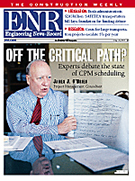|
In the early days of CPM, computing capability was at a premium. Rooting out inconsistencies in scheduling data had to be left completely to the planner. In practice, this meant deliberately limiting the use of the "flexibility" features. Today, the desktop computer I'm using to compose this letter has far more capability than the UNIVAC we used for our first CPM calculations. Thus, there is no reason why the computer cannot be programmed to tell me that my scheduling input is inconsistent and why. Your article seems to imply that Primavera's software is missing an essential data "debugging" feature. Since that software also appears to be an effective monopoly at this time, critics might look to investing in a stand-alone data "debugging" program to test Primavera input data files. The existence of such a program just might convince Primavera to produce their own. Something should be done to elevate the general professional character of today's project schedules.
I have personally been involved with CPM scheduling since the late 1960s and James O'Brien and his activity on arrow technique (ADM) is a good example of someone still holding on to the Model-T technology. It's time to change. We were arguing with him and his firm as far back as the early 1970's that the days of circles and arrows were passe. I, too, feel that the science of scheduling has changed immensely and the younger generation is leading toward developing instruction sheets rather than project measuring tools. Most users do not understand the forward and backward pass to establish early and late dates. Times have changed, however, and veteran consultants also need to change. If we cannot accept the new generation of fancy colored schedules and the software that produces them, we need to step aside. The Project Management Institute (PMI) needs to "update" its thinking to the 21st Century. Your recent cover story focused attention on the need to promote excellence in scheduling, the mission of the new PMI College of Scheduling. Our members and directors are both candid and passionate and the views expressed at the restaurant for your story were our individual views and not those of the college. It will not promote any particular diagramming technique or software design. It will promote better use of the available tools by working with practitioners, software developers, top management, government and academia. Better planning, scheduling and execution of our projects is too important to not get actively involved in trying to improve things. We're holding our first international seminar in Montreal next April 25-27 and we'd like everyone interested in better scheduling to be there. In response to your editorial about critical path scheduling, the real issue here is one of professionalism, morality and ethics. If CPM scheduling is now to be regarded as a "college" course of study, then it seems to me that all of the ramifications of professionalism are necessary. It is possible to deceive others without the use of software. Standards may be helpful, and improvements in the various "tools" are always helpful, but this is a people and not a technology issue. It isn't about what a vendor with a dominant market share does or doesn't provide.
I understand and agree with most of the complaints of the four "scheduling experts" in your story. However, I find fault with their intentional exclusion of Primavera's president, whose office was only 10 miles away. If ENR was attempting to report a news story within the industry, it failed. What it did was report on the complaints of four people, pining for the good old days, who didn't actually want to debate their position. I too wish that schedules were not abused and that schedulers were better trained. I've met many "experts" who couldn't schedule themselves out of a paper sack. Usually, it's only after a schedule has become unusable that the manipulation begins. Blaming the software is short-sighted. Comparing scheduling to gun manufacturing is hyperbole. And altering the software to make it idiot-proof will make it less responsive to project needs. As a professional journal, ENR should not stop at provoking its readers about a topic and should explore the topic, providing equal representation to both sides of an issue and suggesting a path forward.
True schedulers and planners need training in CPM, ADM or PDM, or all three. Sometimes I think having to put a CPM together on paper with a pencil and straight edge is the best teacher because you think it through before diving in. The one analogy I can think of is, if you don't know what 2 plus 2 equals without a calculator, how do you know if your calculator is functioning correctly? Bottom line: don't blame the software, blame the person at the keyboard and the person buying into the end product.
It's not the software, it's the scheduler! Dennis Bryan and Russell Lewton hit it right on the headthe fundamentals of scheduling are being ignored. There is a distinct lack of quality in the preparation of most CPM schedules out there today. Too many alleged schedulers do not rely on the capability of the software, they tailor and fit the schedule to meet their idea of the schedule. Most sched-ules are a waste of the assets required to put them together. Primavera's P3, and its lower-cost counterpart SureTrack, are powerful tools that enable competent schedulers and project management professionals the ability to plan and perform on a project. I do lament the passing of the ADM and believe it is superior to the Precedence Diagram Method. Will I do an Arrow Diagram by hand? Am I going to boycott PDM? "No" to both counts! I am going to make the best use of my assets and knowledge. |
 Y
Y
Post a comment to this article
Report Abusive Comment